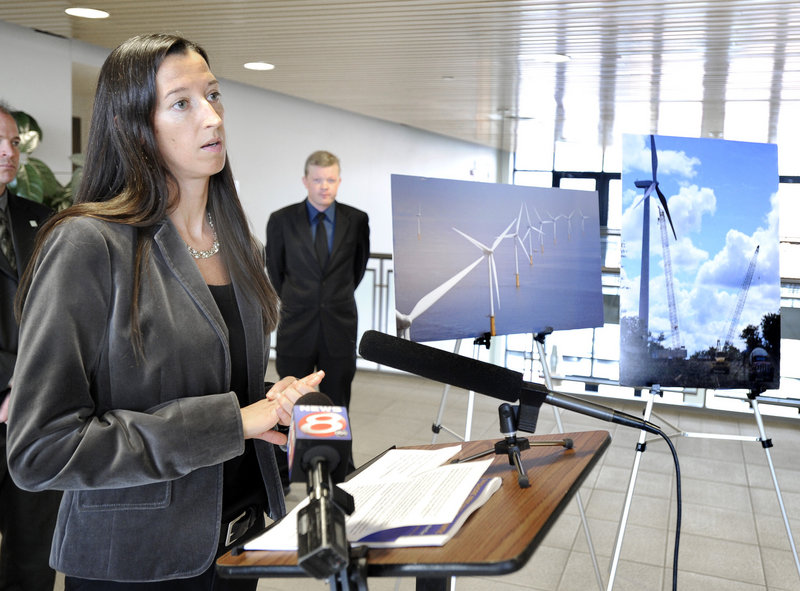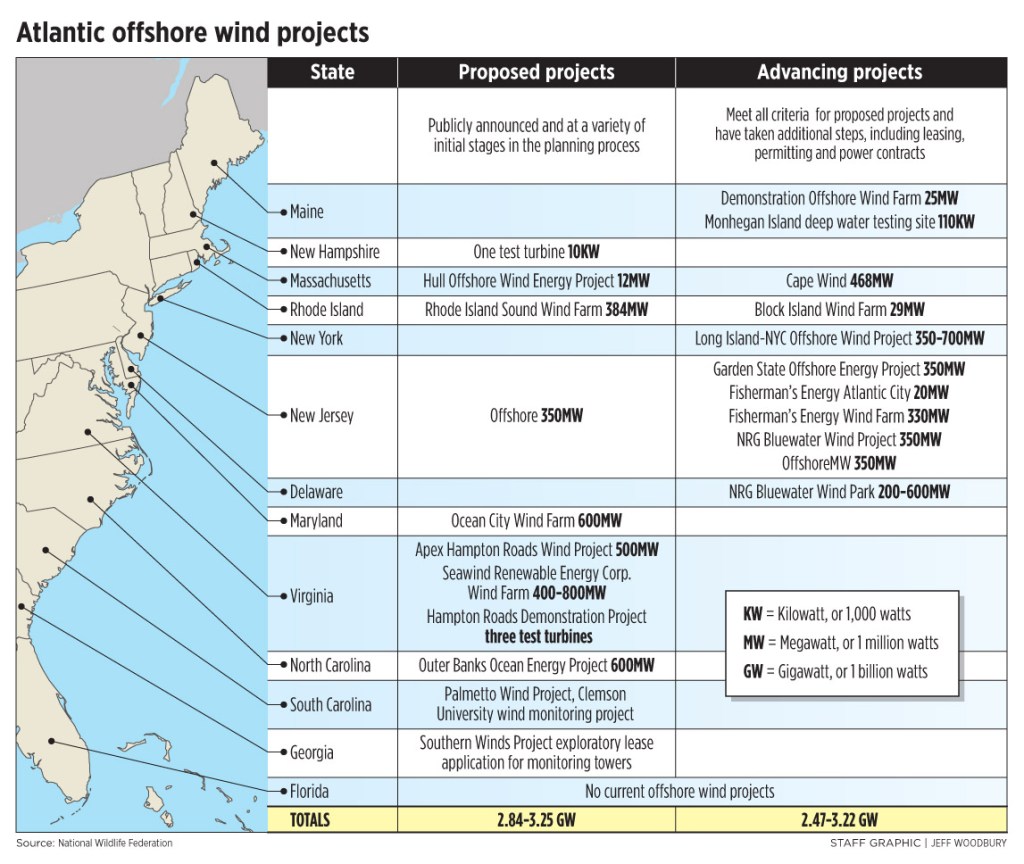PORTLAND – The East Coast can cut its dependence on fossil fuels, expand its economy and create a clean energy future by tapping the vast wind resource in the Atlantic Ocean, a Washington, D.C.-based conservation group said Wednesday.
Flanked by Maine representatives from business, labor and environmental groups, the National Wildlife Federation laid out a vision for how the eastern seaboard can become a hub for ocean wind power. It also offered state-by-state summaries of project proposals and other initiatives from Maine to Florida.
The group noted that while European countries have 948 ocean turbines spinning, with enough capacity to power more than 450,000 homes, not one is operating off the United States.
“This is a huge opportunity for Maine and the country,” said Catherine Bowes, a representative of the conservation group.
Wind power has emerged as Maine’s most divisive energy issue. Broad support from diverse interest groups, such as those at Wednesday’s news conference, is tempered by a small but vocal coalition of residents that questions whether the noise, the visual presence of turbines on ridgelines and today’s high price of wind power are justified.
It appears doubtful that the incoming Republican majority in Augusta, led by Gov.-elect Paul LePage, will embrace wind power with the same enthusiasm as Democratic Gov. John Baldacci. LePage has expressed more interest in finding ways to lower electricity rates in the short term. Wind power, by contrast, produces stable rates over time.
The National Wildlife Federation’s 61-page report was released on a day when the merits of Maine’s current array of land-based wind farms were being lauded, criticized and judged.
At a breakfast in Portland, Baldacci and Cleveland Kapala, a top executive for Calgary, Alberta-based TransCanada Corp., highlighted the jobs and investment linked to the company’s Kibby Mountain project in western Maine. The project’s first phase generated $110 million in in-state spending and 315 construction jobs, Kapala said.
Meeting in Bangor, Maine’s Land Use Regulation Commission tentatively approved the addition of 11 wind turbines to TransCanada’s Kibby Mountain wind farm in western Maine, an expansion opposed by anti-wind groups and some local residents.
Against that backdrop, the National Wildlife Federation and its supporters tried to send a message to politicians and policy makers about offshore wind power: Maine and other states have taken important steps to develop the resource, but continued support is needed in state capitals and in Washington, D.C., to maintain momentum.
Wind power costs more today than the nation’s leading sources of electricity: coal and natural gas. To compete, the industry relies on government incentives, and state and federal policies that encourage development of renewable energy sources.
The National Wildlife Federation calls itself the country’s largest conservation group. It has 4 million members, 10,000 of them in Maine. It considers global climate change — accelerated by burning coal, oil and natural gas — to be the single biggest threat to wildlife, as it brings droughts, severe weather and habitat loss.
At the news conference in Portland, Bowes was joined by representatives from the Natural Resources Council of Maine, Environment Maine and the Conservation Law Foundation, which share those concerns. Also present were interests that benefit from wind power construction, including Parker Hadlock of Cianbro Corp., the state’s largest contractor, and John Henshaw, executive director of the Maine Port Authority, which wants to see more turbines delivered by ship.
“It’s important for our company, it’s important for our state and it’s important for our country,” Hadlock said.
Maine leads New England in the development of land-based wind farms. It has a total capacity of 266 megawatts in operation or being built, and has had $800 million in investment, said Paul Williamson, who directs the Maine Wind Industry Initiative. Maine has a goal of 2,000 land-based megawatts by 2015.
Maine also has ambitious plans to install 5,000 megawatts of capacity far offshore by 2030, enough energy to power an estimated 1.5 million households and spark $20 billion in spending.
Maine has emerged as a national leader in deep-water wind power development, with research centered at the University of Maine. It has three test sites identified, floating prototypes that are set to be deployed next year, and proposals for a 25-megawatt pilot project.
Offshore wind advocates were encouraged last month when Interior Secretary Ken Salazar announced a federal plan to speed up siting of wind projects in the Altantic. It took nearly 10 years to get permits and leases for the controversial Cape Wind project off Massachusetts, a time frame that developers say is unworkable.
To avoid future delays, wind advocates may need to appease critics and skirt costly legal challenges.
Groups including the Citizens’ Task Force on Wind Power point out that the megawatt output claimed for offshore turbines is only about 40 percent of the stated capacity, reflecting the amount of time the wind blows hard enough. That makes wind power too costly, they say, and not worth taxpayers’ subsidies.
“Those subsidy dollars could be better spent on conservation and efficiency,” said Steve Thurston, co-chair of the anti-wind task force.
But Dylan Voorhees, clean energy director for the Natural Resources Council of Maine, said conservation and efficiency can go only so far. “You have to have some form of generation to power the economy,” he said. “You can’t do it with efficiency alone.”
Policy makers should consider jobs, clean air and other benefits of wind, Voorhees said, not just today’s price of electricity. If the cheapest possible power today was the only goal, he said, the only option would be to build coal-fired generators.
The complexity of the issue was highlighted Tuesday, at a business forum in Augusta attended by LePage.
LePage asked Tom Patterson, a development manager for TransCanada, if he could sell wind energy to the state for 5 cents a kilowatt-hour. LePage asked the question after hearing business owners complain that Maine’s high electricity costs are putting them at a disadvantage with competitors in other states.
Patterson’s response was so detailed and nuanced that LePage said he didn’t understand it. LePage asked the same question two more times before Patterson finally gave him a simple answer, which was, “no.”
Jeremy Payne, executive director of the Maine Renewable Energy Association, said that explaining the cost of wind energy is one of the industry’s obstacles.
“That’s a reasonable question: ‘Can you give me cheaper power?’ Payne said. “But compared to what and compared to when? It’s really complicated, how the market works. It’s not a 10-second sound bite.”
Staff Writers Jon Hemmerdinger and Tom Bell contributed to this report.
Staff Writer Tux Turkel can be contacted at 791-6462 or at:
tturkel@pressherald.com
Copy the Story Link
Send questions/comments to the editors.





Success. Please wait for the page to reload. If the page does not reload within 5 seconds, please refresh the page.
Enter your email and password to access comments.
Hi, to comment on stories you must . This profile is in addition to your subscription and website login.
Already have a commenting profile? .
Invalid username/password.
Please check your email to confirm and complete your registration.
Only subscribers are eligible to post comments. Please subscribe or login first for digital access. Here’s why.
Use the form below to reset your password. When you've submitted your account email, we will send an email with a reset code.